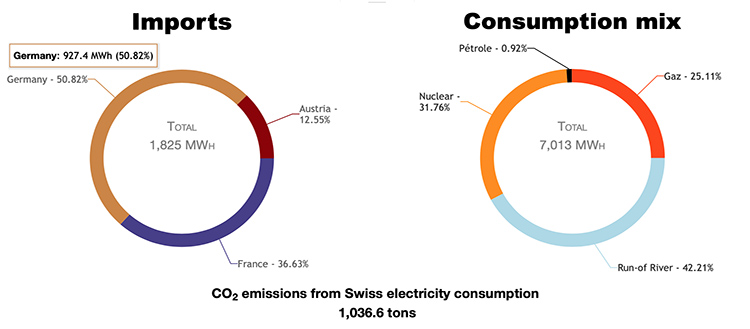What time is Swiss electricity truly green?
The UNIGE is putting a platform online to monitor variations in the composition and carbon emissions of the electricity mix consumed by the Swiss population.

Apart from electricity from French nuclear power plants, part of the electricity imported and consumed in Switzerland is produced abroad in fossil fuel power plants (gas, coal) that emit large quantities of greenhouse gases © J. Kutzera
Where does the electricity we use come from? And what is its impact on the environment? It all depends on the time of day and the season. With its horocarbon platform, the University of Geneva (UNIGE) now makes it possible to track the composition and variations of the Swiss electricity mix. Based on Swiss and foreign production data, this virtual meter is aimed at consumers as well as scientists and policy makers. The platform also offers an interactive tool to evaluate the environmental impact of one’s own consumption and that of certain electrical appliances (fridge, computer, dishwasher).
In Europe, electricity generation is responsible for 25% of all greenhouse gas (GHG) emissions. In Switzerland, where electricity is mainly produced by nuclear and hydroelectric power plants, it accounts for less than 2% of these emissions. However, a large part of this electricity is exported to neighbouring countries, especially in summer when there is a large surplus. To meet its own needs, Switzerland relies on a mix of domestic and imported energy. The latter accounts for around 11% of annual consumption and can be much higher in winter. Apart from electricity from French nuclear power plants, part of the electricity imported and consumed in Switzerland is produced abroad in fossil fuel power plants (gas, coal) that emit large amounts of greenhouse gases.
‘‘The quantification of carbon emissions from electricity generation is generally based on accounting using the ‘producer approach’: these emissions are attributed to the geographical area where they are produced. This approach does not reflect the real carbon impact of a country’s consumption, since it does not take into account emissions linked to imports, which are very significant in the case of Switzerland,’’ explains Elliot Romano, senior scientist in the F.-A. Forel Department of Environmental and Aquatic Sciences at the UNIGE Faculty of Science.
An interactive platform for everyone
To remedy this, the UNIGE developed a new method in 2018. Considering domestic production, imports, consumption by inhabitants and power generation technologies, it also integrates the variations of this mix according to the time of day and the seasons. Thanks to this, the researchers estimate that the average annual carbon footprint of Swiss electricity can be more than five-fold for this ‘‘consumer approach” compared to the abovementioned “producer approach” (up to 161g/kWh of CO2/kWh instead of 29.6g of CO2/kWh in 2017).

Based on this method, the UNIGE has designed a new online tool to track the hourly variations of this electricity mix. It provides information on its composition - the source of imports, the types of renewable or non-renewable energy used - and on the carbon footprint associated with its production and consumption. A second tool allows you to evaluate the GHG emissions of certain appliances (fridge, computer, dishwasher). It is possible to assess one’s own consumption by uploading personal data. Both tools are hosted by the horocarbon platform. They are fed by public data from the European Network of Transmission System Operators for Electricity (ENTSO-E).
At midnight or at noon, carbon emissions are different
For example, on 6 December 2022 at midnight, the horocarbon meter indicated that the Swiss electricity mix consisted of almost 50% imported electricity. Of this, 65% came from Germany, 17% from Austria and 18% from Italy. Most (49%) of the electricity consumed was produced by gas. Its carbon impact amounted to 275g CO2/kWh. On the same day, at noon, the share of imported electricity was zero. Most of the electricity consumed came from domestic generation (esp. hydropower and nuclear). The carbon impact of the consumption was 39g CO2 / kWh.
‘‘The aim of this platform is to provide relevant indicators for assessing the impact of electricity consumption,’’ explains Elliot Romano. ‘‘By highlighting, for example, the periods of time when the share of renewable energy in the electricity mix is highest, it can encourage people to consume more wisely. This information can also be useful for scientists and policy makers who want to measure the effects of certain energy strategies.’’ Currently, the virtual meter transmits information with a time lag of two days. Eventually, the aim is to make it available as real-time monitoring tool.
